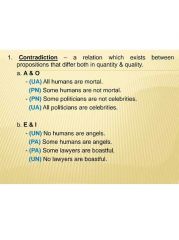![]()
![]()
![]()
Use LEFT and RIGHT arrow keys to navigate between flashcards;
Use UP and DOWN arrow keys to flip the card;
H to show hint;
A reads text to speech;
20 Cards in this Set
- Front
- Back
|
Contrapositive |
Contraposition is a law that says that a conditional statement is logically equivalent to its contrapositive. [The contrapositive of the statement has its antecedent and consequent inverted and flipped]: the contrapositive of P-> Q is thus -Q->- P For instance, the proposition "All bats are mammals" can be restated as the conditional "If something is a bat, then it is a mammal". Now, the law says that statement is identical to the contrapositive "If something is not a mammal, then it is not a bat." |
|
|
Obversion |
ObversionIn traditional logic, obversion is a "type of immediate inference in which from a given proposition another proposition is inferred whose subject is the same as the original subject, whose predicate is the contradictory of the original predicate, and whose quality is affirmative if the original proposition's quality was negative and vice versa". The quality of the inferred categorical proposition is changed but the truth value is equivalent to the original proposition. The immediately inferred proposition is termed the "obverse" of the original proposition, and is a valid form of inference for all types of categorical propositions. In a universal affirmative and a universal negative proposition the subject term and the predicate term are both replaced by their complements: The universal affirmative is obverted to a universal negative. "All S are P" and "No S are non-P" "All cats are animals" and "No cats are non-animals" The universal negative is obverted to a universal affirmative. |
|
|
Conversion |
Conversion is the inference in which the subject and predicate are interchanged. In modern logic it is only valid for the E and I propositions. The valid converse is logically equivalent to the original proposition. In traditional logic, the A proposition has a converse by limitation which is the subaltern of the invalid A-converse; i.e., the corresponding I proposition. The converse by limitation is implied by the original but is not (usually) equivalent to it. |
|
|
Quality |
The quality of a categorical proposition is determined by whether the asserted class relation is one of exclusion or inclusion (i.e., affirmative or negative). |
|
|
Quantity |
The quantity of a categorical proposition is determined by whether or not it refers to all members of its subject class (i.e., universal or particular). The question "How many?" is asking for quantity. |
|
|
Distributed Term |
A distributed term is a term of a categorical proposition that is used with reference to every member of a class. If the term is not being used to refer to each and every member of the class, it is said to be undistributed. |
|
|
Deductive Argument |
A deductive argument is defined as one whose premisses are claimed to provide conclusive evidence for the truth of its conclusion. |
|
|
Valid Deductive Argument |
A valid deductive argument is one in which it is impossible for the premisses to be true without the conclusion being true also. |
|
|
Categorical Proposition |
A categorical proposition is defined as any proposition that can be interpreted as asserting a relation of inclusion or exclusion, complete or partial, between two classes. |
|
|
Class |
A class is defined as a collection of all objects which have some specified characteristic in common. This is no more complicated than observing that the class of "lightbulbs" all have the common characteristic of "being a lightbulb." |
|
|
Class Concept Explained |
Thus, we can have four class relations in the various kinds of categorical propositions:Utilizing the classes, "people" and "good beings":a. complete inclusion>>>"All people are good beings."b. complete exclusion>>>"No people are good beings."c. partial inclusion>>>"Some people are good beings."d. partial exclusion>>>"Some people are not good beings." |
|
|
Conditional statement |
In logic, a conditional is a compound statement formed by combining two sentences (or facts) using the words "if ... then." A conditional can also be called an implication. |
|
|
Antecedent |
An antecedent is the first half of a hypothetical proposition, whenever the if-clause precedes the then-clause. It is also known for a person's principles to a possible or hypothetical issue.Examples:If P, then Q. |
|
|
Consequent |
A consequent is the second half of a hypothetical proposition. In the standard form of such a proposition, it is the part that follows "then". In an implication, if \phi implies \psi then \phi is called the antecedent and \psi is called the consequent.[1]Examples:If P, then Q.Q is the consequent of this hypothetical proposition. |
|
|
Complement |
n logic, negation, also called logical complement, is an operation that takes a proposition p to another proposition "not p", written ¬p, which is interpreted intuitively as being true when p is false and false when p is true. |
|
|
Logical Opposition of a Proposition |

|
|
|
Contradiction |

|
|
|
Contrariety |

|
|
|
Subcontrariety |

|
|
|
Law of Contradiction |

|

